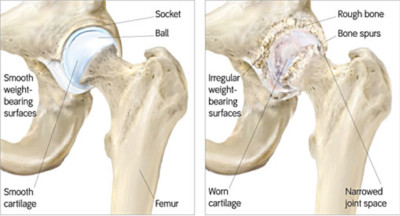As with joints that bear the weight of your body, “wear and tear” arthritis otherwise called osteoarthritis is among the most prevalent causes of hip pain. The glossy, smooth covering of the articular cartilage that covers the end of your bones that aids in the gliding of your hip joint may eventually wear thin.

OSTEOARTHRITIS INTRODUCTION
Cause of Osteoarthritis
If you have a family history of the disease, then you will be more inclined to acquire the illness. Other high risk conditions that foster the disease includes being elderly, obese or having an injury that causes enormous stress on the cartilage of your hip. You may also develop osteoarthritis even without having any of the above factors of risk.
Symptoms of Osteoarthritis
Initially, after waking up in the mornings you may experience some stiffness and discomfort in your buttocks, groin or thigh. The pain intensifies with a greater level of activity but lessens with periods of rest. Unless you are treated for osteoarthritis of the hip, the disease will worsen until rest is no longer an effective pain relief. The joints of the hip gradually stiffens and become inflamed. Spurs of bone might amass at the ends of the joints. Once the cartilage completely wears away, your joints will no longer be shielded and the bones will rub against one another. The simple act of moving will become an extremely painful for your hip and other joints.
Diagnosis of Osteoarthritis
After describing your symptoms and when they began, we will be able to ascertain the exact progression of the disease. We will check for pain by flexing, rotating and extending your hips. You may be required to stand on a single leg or walk so that we can observe the alignment of your hips. Both of your hips might be x-rayed to further examine changes in the spacing of your hip joints and if bone spurs and other abnormalities have developed.
Treatment of Osteoarthritis
Although it is not possible to reverse the impact of osteoarthritis, nonsurgical treatment in the early stages can aid in the avoidance of extreme pain, impairment and the gradual advancement of the disease. If your condition is severe, surgery may be an alternative option for you.
-
Nonsurgical Treatment
If you have early stages of osteoarthritis of the hip, the first treatment may be:
- Rest your hip and use them as minimally as possible
- Adhere to a physical therapy regimen of regular, mild exercises such as water aerobics, swimming or cycling. This will help to maintain joint function and better its mobility and strength.
- Use anti-inflammatory drugs that does not contain steroids such as ibuprofen for pain
- Get adequate sleep every night
- If you are overweight, you may be required to lose some weight.
- During the progression of the disease, you may require the use of a cane.
-
Surgical Treatment
If you have later stages of osteoarthritis, your hip joint hurts when you rest at night, and/or your hip is severely deformed, your doctor may recommend total hip replacement surgery (arthroplasty).
Here’s an interview that Dr Kevin Lee did with Channel 8 about Osteoarthritis Treatment in Singapore. For the English interview, please view Hyaluronic Acid Injections
Looking For A Reliable Hip Orthopaedic Specialist?
Fast Medical Attention, Transparent Fees
Make an appointment for comprehensive care for your hip problems!
